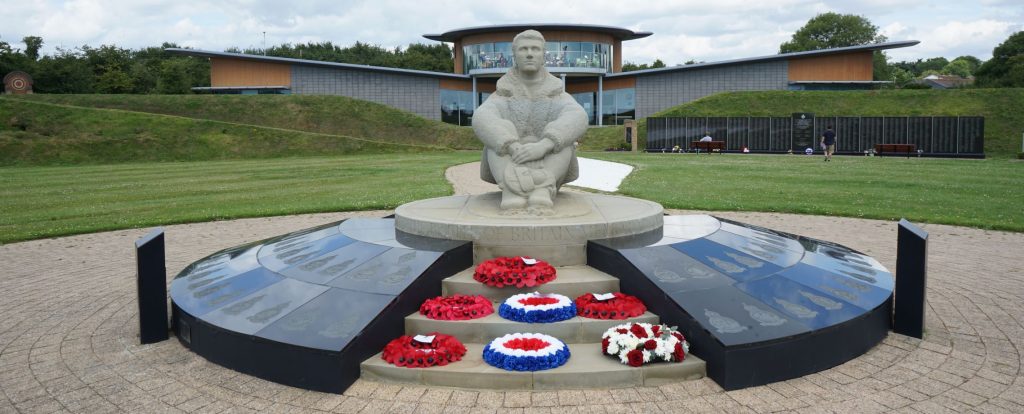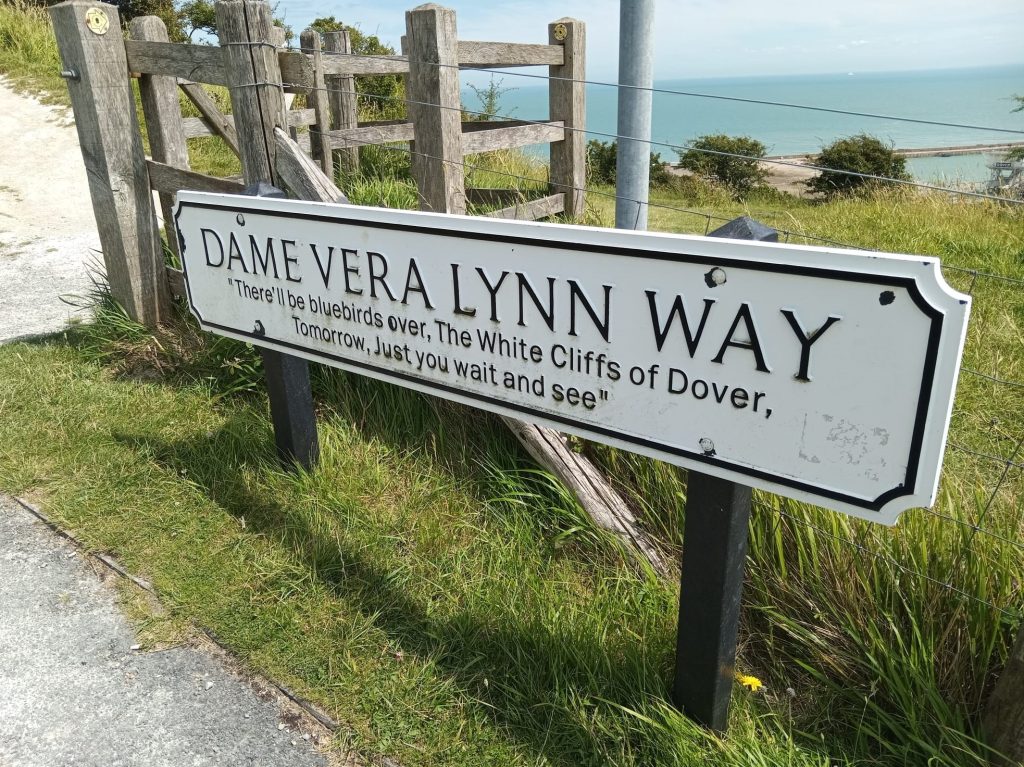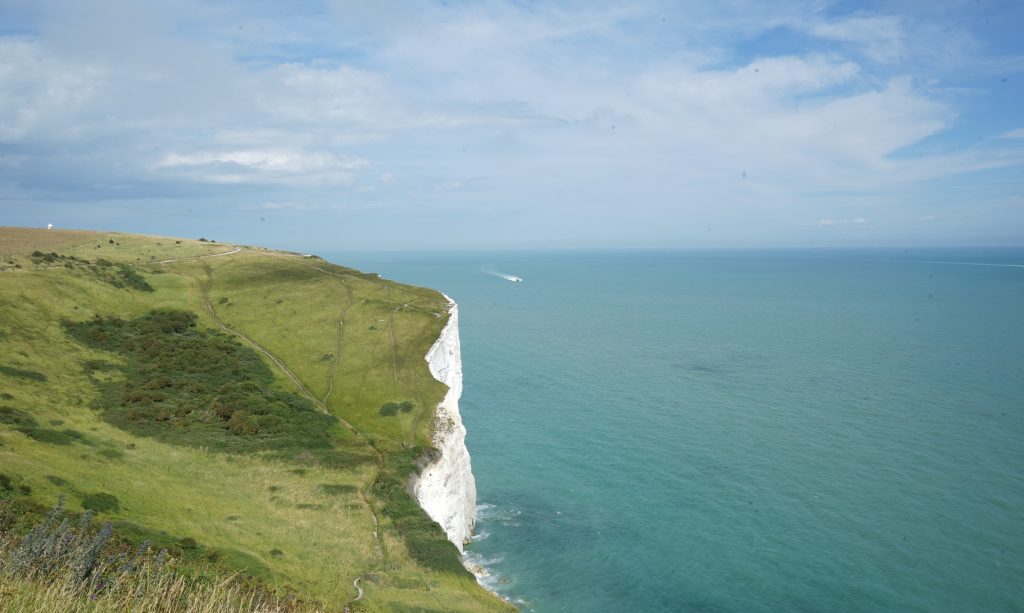‘There’ll be blue birds over, the White Cliffs of Dover‘

Wherever I travel, with only a few very rare exceptions, I have found that bus drivers are always happy to help out an international visitor. This day was no different, and as the bus slowed, the driver glanced up at the mirror and gave me a wave. ‘Battle of Britain Memorial‘ he announced cheerfully, and I thanked him as I headed for the door. I had travelled a short distance east of Folkestone, Kent, to the outskirts of the small village of Capel-Le-Ferne. Crossing the road, I came to the entrance of the Battle of Britain Memorial.

I took the path to the left, having decided to check out the site’s visitor centre, ‘The Wing’ first. (The building is named after the elliptical wing, commemorating the Spitfire’s design, that is incorporated into its architecture.) Once inside, I bought a ticket for the Memorial’s ‘Scramble Experience’ interactive museum.
Apart from a couple with their young son, I had the room to myself. Rather than presenting artefacts, the Scramble Experience tracked the story of the Battle of Britain through impressive, state-of-the-art audio/visual displays. Touch screens allowed you to find out more information around specific areas of interest. Although I’m quite content with an old-school, dusty-cabinet-and-typed-information-card sort of museum, this more high tech presentation is sure to be a hit with the kids. And getting young people to learn and appreciate what happened 80-odd years ago is the only way to ensure the history is preserved.
Along with facts, stats and figures, the Memorial also focused on the human side of the Battle of Britain. A short dramatic film, depicting nervous pilots on standby within a dispersal hut, and first-hand accounts from veterans, personalised the Battle of Britain experience.
‘The solemn boredom and the rush of excitement. The scramble, the clear and steady voice of the Controller giving us directions and height, the number of enemy aircraft, ever-growing, sometimes into hundreds. And we were only twelve Hurricanes. We hoped and prayed that other squadrons had also been scrambled, but we never saw them. We just went ploughing in, picked our targets and fought. Shots of adrenaline and dryness of mouth. The natural worry of life and death.’ Pilot Officer Harold Bird-Wilson

Harold Arthur Cooper Bird-Wilson was born in Prestatyn, and joined the RAF in 1936. During the Battle of Britain he flew Hurricanes with 17 Squadron. In September 1940 he was awarded the Distinguished Flying Cross, the citation stating: ‘Flying Officer Bird-Wilson has shot down six enemy aircraft and shared in the destruction of several others. He has shown fine fighting qualities and determination in his attacks‘. Despite being shot down on 24th September, Air Vice Marshall Bird-Wilson survived the Battle of Britain and the War, retiring from the RAF in 1974.1,2
After having made my way thought the Scramble Experience, I left The Wing and went back out into the sunshine and cool breeze. The Christopher Noxley-Morris Memorial Wall stands in front of the The Wing, listing the names of all air crew that are known to have flown at least one sortie during the Battle of Britain.


The flowers and wreaths left by visitors added bright colour to The Wall’s sombre tones.

At the far end of The Wall stood a bust of Lord Hugh Dowding, Commander-in-Chief of RAF Fighter Command during the Battle of Britain.
And beside him, Air Chief Marshall Sir Keith Park, Commander of No. 11 Fighter Group during the Battle. Standing in the warm sun, I thought back to cold and rainy day I had visited Sir Keith’s memorial in his home town of Thames, New Zealand, four years ago.

The Battle of Britain Memorial itself is an evocative sculpture of a seated airman, gazing out across the Channel. The figure is placed at the centre of a three-bladed propeller that stretches across the expanse of grass between The Wing and the cliffs.


Looking past the airman’s shoulder, I wondered if he was waiting for a missing pilot to return. The mound visible in the back-left of the photo below is the former position of one of the Royal Artillery’s Capel Battery guns.

A series of interpretive panels on the site of the Memorial included this quote describing an action on August 16th 1940:
‘The first shell tore through the hood over my cockpit and sent splinters into my left eye…I couldn’t see through that eye for blood. The second shell struck my spare petrol tank and set it on fire… The fourth shell struck the back of my left foot. I was just thinking about jumping out when suddenly a Messerschmitt 110 whizzed under me and got right in my gun-sight…I plugged him first time.‘ Flight Lieutenant James Nicolson
By delaying baling out of his stricken Hurricane, Flight Lieutenant Nicolson ‘sustained serious burns to his hands, face, neck and legs‘3. For this action, he was awarded the Victoria Cross, the only pilot of RAF Fighter Command to receive this decoration during WWII.3

James Brindley Eric Nicolson was born in Hampstead, and joined the RAF before the War. He flew Hurricanes with No. 249 Squadron RAF during the Battle of Britain, and was shot down on August 16, 1940 over Southampton. Wing Commander Nicolson went on to serve in the Far East, and was killed in an plane crash in the Bay of Bengal on 2nd May, 1945.3
I really enjoyed my time at the Battle of Britain Memorial at Capel-Le-Ferne. It’s an impressive site and definitely worth a visit. But it was now early afternoon and time to head further east along the coast. I was keen to see a place synonymous with the Battle of Britain, with a name that had been familiar to me since I was a kid.
Another bus ride and I was in Dover, and from there I walked east towards the ferry port. Only about 32km from the France at its narrowest point, it is little wonder this section of coast saw so much action during the Battle of Britain. From the Port I was soon climbing towards the National Trust Visitor’s Centre, on what I discovered was the ‘Dame Vera Lynn Way’.

I have to admit, I always thought the lyric was ‘There’ll be blue skies over…’
With regards to the honouring of her famous mum, Dame Vera’s daughter Virginia stated: ‘The re-naming of the footpath to ‘Dame Vera Lynn Way’ is a touching tribute as my mother always remarked the White Cliffs were the last landmark seen as the boys went off to war and the first they saw when they returned home.’ 4
From the Visitor’s Centre I was soon on top of the famous White Cliffs, and although there was a steady stream of visitors enjoying the sweeping views, I was able to find some quiet time to myself.


With the clifftops looking much as they did 80-odd years ago, it wasn’t hard to look out to sea and imagine the air battles over the Channel that occurred in the summer of 1940.
I wondered what had drawn the other visitors to the White Cliffs on that sunny afternoon: the Chinese tour groups; the young European backpackers; and the older visitors powering along with their walking poles and daypacks. Was it the connection to the Battle of Britain? The desire to visit a famous place? Or a good spot to enjoy the outdoors?
I passed the South Foreland Lighthouse, and began the descent to the village of St Margarets Bay.

It was then I heard the distinctive growl of an aircraft engine, and looked up to see a Spitfire. A Spitfire. From out at sea it crossed the coastline, before heading inland and disappearing from sight. There are several companies offering flights over the Cliffs in Spitfires modified to carry a passenger. After visiting the Battle of Britain Memorial, then walking the White Cliffs of Dover, I couldn’t have asked for a better or more poignant end to my day.

My search for The Few was becoming quite an odyssey, with each location revealing further places to explore. For my next stop I would be leaving Kent, and heading to North-West London to visit the wartime Headquarters of RAF Fighter Command.
A few tips for visiting the Battle of Britain Memorial, Capel-Le-Ferne, and the White Cliffs of Dover
- The Battle of Britain Memorial grounds can be accessed every day, with The Wing building open 1000 until 1700 from 1 Mar to the end of September, and 1000 until 1600 from 1 October until the end of February. The Scramble Experience is the only ticketed feature at the Memorial and pricing is very reasonable. For more information visit The Battle of Britain Memorial homepage
- The Battle of Britain Memorial site is well is well presented to appeal to all ages so you won’t have to worry about the kids getting bored
- There is no photography permitted within the Scramble Experience so use your phone or bring a notebook if you want to make a few jottings
- The English bus network is impressive, and I had no problems visiting the Battle of Britain Memorial from Folkestone and then getting myself to the White Cliffs of Dover without a car
- Although I didn’t this time around, you can tour the WWII Fan Bay Deep Shelter as part of your visit to the Cliffs, and also the South Foreland Lighthouse. For general information visit the National Trust White Cliffs of Dover website
1The Battle of Britain London Monument, 2007, ‘The Airmen’s Stories – F/O H A C Bird-Wilson‘
2Air Of Authority, 2023, ‘Air Vice Marshall H A C Bird-Wilson‘
3 Peel, M., 2024, ‘Wing Commander James Brindley Nicholson VC DFC, 355 SQN, RAF – ‘A Determined Pilot’, Commonwealth War Graves Commission
4Dover District Council, 2021, ‘Wildflowers Over the White Cliffs of Dover’
If you enjoyed this post, you may also like Searching For The Few Part I and Part II
Leave a Reply